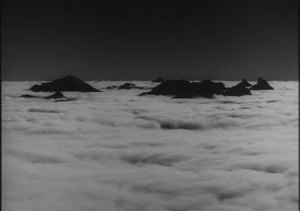[Excerpts from Paul Virilio’s War and Cinema: The Logistics of Perception (1984/89)]
From the original watch-tower through the anchored balloon to the reconnaissance aircraft and remote sensing satellites, one and the same function has been indefinitely repeated, the eye’s function being the function of a weapon.
The industrial production of repeating guns and automatic weapons was thus followed by the innovation of repeating images.
A war of pictures and sounds is replacing the war of objects (projectiles and missiles)
War can never break free from the magical spectacle because its very purpose is to produce that spectacle: to fell the enemy is not so much to capture as to ‘captivate’ him, to instill the fear of death before he actually dies.

…the history of battle is primarily the history of radically changing fields of perception.
“I still remember the effect I produced I produced on a small group of Galla tribesman massed around a man in black clothes,” reported Mussolini’s son during the Abyssinian war of 1935-36. “I dropped an aerial torpedo right in the centre, and the group opened up just like a flowering rose.”

Rudolph Arnheim once remarked that, after 1914, many film-actors became props and the props took the leading role. Similarly, women became the objective tragedy in the wars from which they were excluded.
The star system and the sex symbol were the result of that unforeseen perceptual logistics which developed intensively in every field during the First World War.

“World War One was the reason for Hollywood”.
Cinemas, too, were training camps which bonded people together in the face of death agony, teaching them to fear the death of what they did not know – or rather, as Hitchcock put it, of what did not exist.

…the Allies’ victory in the Second World War was at least partly due to their grasp of the real nature of Nazi Lebensraum, and to their decision to attach the core of Hitler’s power by undermining his charismatic infallibility. They did this by making themselves the leading innovators of film technology.
Eyesight and direct vision have gradually given way to optical or opto-electronic processes, to the most sophisticated forms of ‘telescopic sight’.
Only serial photography was capable of changing troop positions or the impact of long range artillery, and hence the capacity of new weapons for serial destruction.

As Andre Malraux wrote: “Caesar could have conversed with Napoleon, but Napoleon has nothing to say to President Johnson”
Positional warfare, then, had had its day. The extreme mobility of mechanized armies impaired a new temporal unity that only cinema could apprehend.

Just as weapons and armour developed in unison throughout history, so invisibility and visibility now began to evolve together, eventually producing invisible weapons that make things visible.
The projectile’s image and the image’s projectile form a single composite. In its tasks of detection and acquisition, pursuit and destruction, the projectile is an image of ‘signature’ on a screen, and the television picture is an ultrasonic projectile propagated at the speed of light.

January 27, 2013 at 5:49 pm
Great excerpts interspersed with images. Virilio strikes me as an essential read. Thanks for introducing.
LikeLike
February 3, 2013 at 7:55 pm
Yes, pretty essential stuff. My pleasure.
LikeLike
February 16, 2013 at 11:53 pm
Reading Crepuscular Dawn for starters.
Would you recommend Deleuze’s Cinema 1 & 2, Rancière’s Future of the Image & The Emancipated Spectator?
LikeLike
February 16, 2013 at 11:58 pm
Haven’t read either of the books yet, Ahimaz. Sorry, can’t help you there.
LikeLike